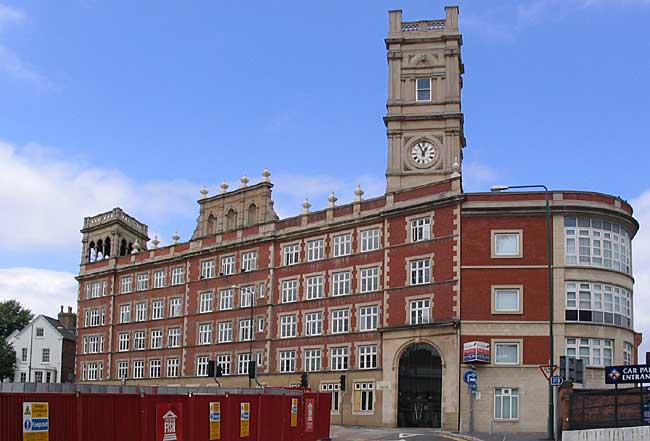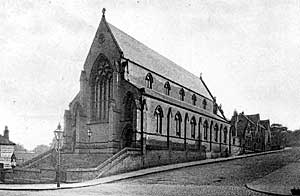< Previous | Contents | Next >
Ilkeston Road, Alfreton Road, Talbot Street, Wollaton Street
Ilkeston Road is nowadays a sufficiently dreary thoroughfare, but it was a country lane until 1796 with a style where "The Sir John Borlace Warren" now stands. This worthy, by the way, was an Admiral, an owner of celebrated racehorses and a country gentleman who settled down on his family estate at Stapleford during the third quarter of the 18th century. In 1796 a certain Benjamin Darker built the first house in New Radford round about the top of Ilkeston Road. The district was then spoken of as the "New Buildings" and there was nothing whatever between them and St. Peter's Church, Old Radford except open fields. To-day there is nothing that one can say in favour of this industrial neighbourhood, for Christ Church which serves the district was built in 1847 when architecture was at its lowest ebb and when beauty was at a discount.
Alfreton Road is chiefly interesting for the fact that there was a toll chain across it just about Thackeray's Mill which remained in existence until about the middle of last century. What the toll rights were and under what conditions they were levied I have been unable to discover. Further down Alfreton Road on the western side is "The Spread Eagle Hotel" where Herbert Spencer, the great thinker and philosopher, who was born in Derby in 1820 and who did not die until 1903, resided for some years.
Talbot Street is another rather uninteresting thoroughfare in spite of the attempt to cheer it by the architecture of Lambert's factory. Upon the facade of number 53 is painted "High Holborn" but it is almost weathered away and it represents the old name of the Terrace. St. Matthew's Church was built in 1853 and it is a decided improvement on Christ's Church, but still a far from lovely building. It is interesting to note the intrusion of the Leicestershire type of building which occurs in the construction of its schoolroom. The Victoria Hall which has had a strenuous career, being used for all sorts of entertainments began life as a skating rink in 1876.

Lambert's factory on Talbot Street was built in 1864 and converted into offices in the 1990s (photo: A Nicholson, 2005).
Wollaton Street is a thoroughfare with some history. It was called Back Lane until 1852 and is a continuation of Parliament Street or Back Side as it was anciently called because it was on the back of the town defences. This route, however, connects up with Coalpit Lane so I think we may assume that Wollaton Street came into general use about the same time that Coalpit Lane was adopted as the main route of traffic by which the coal from Wollaton pits was taken to the town wharfs in the 17th century. The gradient of this route when compared with any other way is distinctly easier and even to-day Wollaton Street is generally chosen in preference to Derby Road for this very purpose. It must have carried a great deal of traffic even before this date for it is a deeply sunken road as is shown by the height of St. Matthew's Vicarage and other houses in its neighbourhood above the road surface and this sinking could only be accounted for by the wear and tear of very ancient traffic. In 1852 it was very much modernised, a great deal of rock was cut away from its northern side and it was re-christened Wollaton Street.
Just at the corner of Shepperson Street are the Wollaton Street alms houses of which the Mayor has disposal and whose inmates although they get no pension receive a load of coal at Christmas. Further down on the south side will be found a little street called Bow Street which was known to our forefathers as Mill Street for in it was erected Hargreaves' mill, the first cotton mill in the world. Some fragments of this mill still remain and there is a notice board over it giving some slight account of its history. It was erected in 1767 by Hargreaves and his partner, James, and within it they traded with more or less success until Hargreaves' death, but circumstances were against Nottingham and the cotton spinning industry has moved away to Lancashire leaving this mill entirely derelict.
In Hanley Street, just by the Electricity Works are the modern Hanley Street Hospitals which are the successors of alms houses erected in Barker Gate under the will of Henry Handley. The ancient date-stone is preserved and is built into the modern buildings, and it gives a long account of the wishes of the founder and concludes by saying that Handley died on the 10th day of June, 1650.
Derby Road itself, in spite of its heavy gradient is one of the busiest streets in the city. In early days a toll house was erected at the bottom of the hill, probably about opposite the present Toll Street, hence the name, and Derby Road itself was called Toll House Hill until 1855.
It is an ancient road pushed to the north in order to avoid the steep valley of the park and down to 1740 it was, like Back Lane, a deep sunken road with soft sandstone cliffs on either side. Its condition was so deplorable that in 1740 it was taken in hand by Lord Middleton who, at his own expense threw down these sandstone cliffs and with the debris thus obtained, filled up the hollow way and made some sort of a road surface. In the course of these operations certain caves and antiquities were discovered which contemporary antiquaries described either as ancient British or Druid. Unfortunately no accurate plan seems to have been made of them and the curios, which included a stone celt, have disappeared, so that nothing definite can be said upon this subject. On the north side about where number 96 now stands was erected the Lancastrian School. These schools which were set up all over the country mainly under the auspices of the British and Foreign School Society were conducted on a system introduced by Joseph Lancaster, a member of the Society of Friends. His system was somewhat akin to the monitorial system familiar to us all nowadays and under it use was made of the service of more advanced pupils in teaching the beginners. Lancaster himself had a flourishing school on this system in his father's premises in the Borough Road, London, and so enthusiastic did he become that he spent a considerable time travelling the country advocating the introduction of schools, but unfortunately in 1811 he became insolvent and soon afterwards he was obliged to migrate to America where he died in 1838.
Labray's hospital which is familiarly known as "Labourers Hospital" stands at the corner of Vernon Street. It is a modern building which has taken the place of an older construction which was founded under the will of a certain Jonathan Labray who was a framework knitter at Calverton. He removed to Nottingham and entered upon the hosiery business and accumulated a certain fortune. He died a bachelor and left the bulk of this fortune to Thomas Smith who acted as executor under the will of Abel Collins for him to erect and endow a hospital in Nottingham for poor and aged frame-work knitters.
 The Baptist chapel on Derby Road was built
c.1850 and closed in the mid-1960s.
The Baptist chapel on Derby Road was built
c.1850 and closed in the mid-1960s.Derby Road Baptist Church on the south side of the road is rather a striking structure, and contains an excellent four-manual organ. The church was erected in 1850 at a cost of £5,000 by a section of the congregation which had originally worshipped in George Street. In 1847 this party seceded from the parent church and took a room in Clinton Street wherein to conduct their worship, from where they migrated to the Friends' Chapel in Spaniel Row and from thence it is believed to the old Mechanics premises in St. James's Street. The Chapel suffered a disastrous fire in 1893, but it was completely restored and re-opened for worship in the following year.
St. Barnabas Roman Catholic Cathedral which is the finest modern Gothic building in the city, was founded in 1841 and was consecrated in 1844. It was built from the designs of Augustus Welby Pugin, the brilliant architect who did so much for the Gothic revival. It is of the revived Early English style and its proportions and details are really very beautiful. The best time to see it is on a moonlight night when its silhouette stands out in a most striking manner.
The original Albert Hall was built in 1876 from designs by Mr. Watson Fothergill, and in 1900 it was bought by the Wesleyan Methodists for £8,450 in order to establish a mission therein. Six years later it was completely burned to the ground and it was not until 1909 that the present building, which is the best public hall in the city, was opened.
Two points of interest of this thoroughfare remain to be mentioned, the first being that that curious little thoroughfare just by number 2 Derby Road which is called officially Poynton Street, although not so marked, is named after a certain widow Poynton who, in 1619 was ducked for a scold, and the second point is that in 1335, five years after the arrest of Mortimer, William de Amyas had a mill at the foot of Derby Road. Whether this mill was a windmill or a horse mill is not known, but it is interesting to remember that in 1339 he founded a Chantry in St. Mary's Church with two chaplains. It is rather interesting to copy from Mr. Hood's book on St. Mary's Church the actual words of the foundation of this chantry:—
"I make this chartre with al my wille
Godde's service for to fulfil
Therefore shall he have no lesse
Than Godde's curse that disturbs this Messe."
